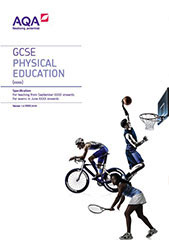3.1.3 Physical training
Students should develop knowledge and understanding of the principles of training and different training methods in order to plan, carry out, monitor and evaluate personal exercise and training programmes.
The relationship between health and fitness and the role that exercise plays in both
Content |
Additional information |
|---|---|
Health and fitness |
Definitions of health and fitness. |
The relationship between health and fitness |
Decreased fitness because of ill health, ie poor health can result in an inability to train, lowers fitness. Increased fitness despite ill health, ie unhealthy but able to train, increases fitness. |
The components of fitness, benefits for sport and how fitness is measured and improved
| Content | Additional information |
|---|---|
| The components of fitness | Definitions of the following components of fitness:
|
| Linking sports and physical activity to the required components of fitness | Understand and justify why the components of fitness (as stated above) may or may not be needed when performing certain physical activities and sports. |
| Reasons for and limitations of fitness testing | Reasons for fitness testing:
Limitations of fitness testing:
|
| Measuring the components of fitness | Knowledge of the main procedures of the tests used to measure the following
components of fitness:
Testing procedures refers to ‘how each test is carried out’ and includes reference to how the test is organised (when applicable) in relation to the following:
Evaluate whether or not these tests are relevant to performers in different sporting activities. |
| Demonstration of how data is collected for fitness testing | Understanding of how test scores are measured/recorded (eg in seconds, levels, centimeters, numbers). Definitions of the terms qualitative and quantitative, in relation to the collection of fitness testing data. Understanding that the quantitative data collected during fitness testing can be compared to national averages. |
The principles of training and their application to personal exercise/training programmes
Content |
Additional information |
|---|---|
The principles of training and overload |
Key principles of training. SPORT to include:
Key principles of overload. FITT to include:
Students should be taught the terms and what they mean. |
Application of the principles of training |
How the principles of training can be applied to bring about improvements in fitness. Application of the principles to sporting examples. |
Types of training |
Understand the distinctions between different types of training. Circuit training – consider space available, equipment available, number of circuit stations, work:rest ratio, the content/demand of the circuit can be altered in order to improve different components of fitness. Continuous training – sustained exercise at a constant rate (steady state) without rests, involving aerobic demand for a minimum of 20 minutes, eg running, swimming, rowing, cycling. Fartlek training – varying speed, terrain and work:recovery ratios. Interval training/high intensity interval training – periods of exercising hard, interspersed with periods of rest or low intensity exercise. Static stretching – a way to stretch to increase flexibility, held (isometric) for up to 30 seconds, using correct technique, advisable to avoid over stretching. Weight training – choice of weight/exercise depends on fitness aim, eg strength/power training or muscular endurance, the importance of safe practice/lifting technique, the need for spotters. Plyometric training – use of plyometric exercises, eg bounding, depth jumping, to increase power. Basic physiological understanding (eccentric contraction followed by larger concentric contraction). Any training (and practice) method must take account of the following:
|
Identification of the advantages and disadvantages (the effects on the body) of training types linked to specific aims |
The advantages and disadvantages (the effects on the body) of each type of training method stated above. Students should be taught to select and evaluate appropriate training methods for various (aerobic and anaerobic) fitness needs and make links to sporting activity, eg continuous training is fully appropriate to marathon runners. |
How to optimise training and prevent injury
Content |
Additional information |
|---|---|
Calculating intensities to optimise training effectiveness |
Definition of training threshold. Calculate the aerobic/anaerobic training zone:
For circuit training, altering the time/rest/content of the circuit will determine the fitness aim. How to calculate one repetition maximum (one rep max) as part of weight training and how to make use of one rep max, with reference to:
|
Considerations to prevent injury |
The training type/intensity should match the training purpose (eg aerobic or anaerobic). Where applicable, the following factors should be taken into account in order to prevent injury:
|
Specific training techniques – high altitude training as a form of aerobic training |
How high altitude training is carried out:
Students should be taught to evaluate the benefits and the limitations of altitude training for different sports performers. Students do not need to be taught how to calculate intensities for altitude training. |
Seasonal aspects |
Names of the three training seasons:
An understanding of what each of the seasons entails (aims):
An understanding of the benefits of each season to the performer. Students should be taught to apply and justify the characteristics of the seasonal aspects to different sporting activities. |
Effective use of warm up and cool down
Content |
Additional information |
|---|---|
Warming up and cooling down |
The constituent parts of warming up and cooling down. Warming up should include:
Cooling down should include:
Students should be taught to understand and justify appropriate elements of a warm up and a cool down for different sporting activities. The benefits of warming up:
The benefits of cooling down:
|
